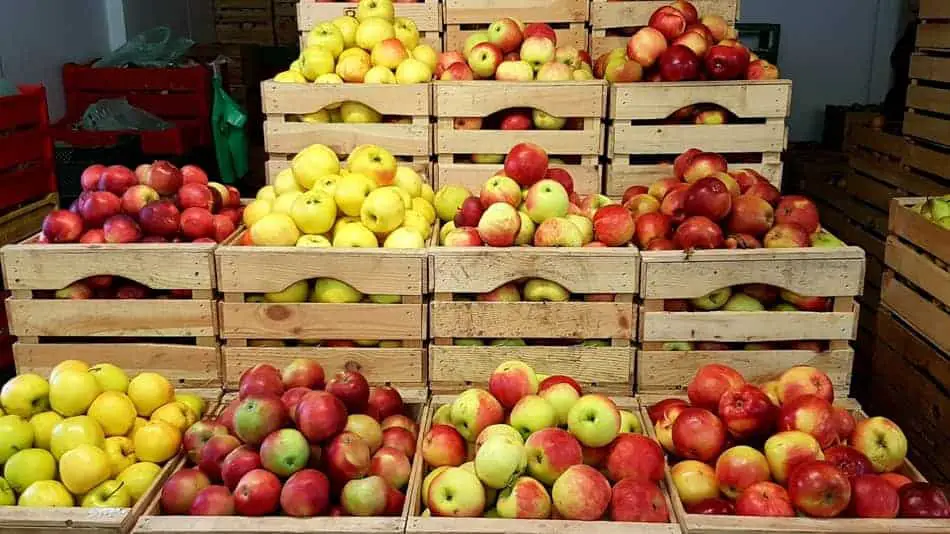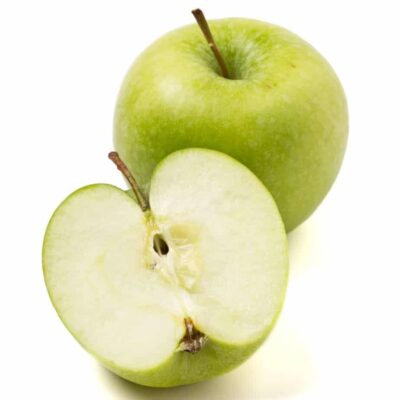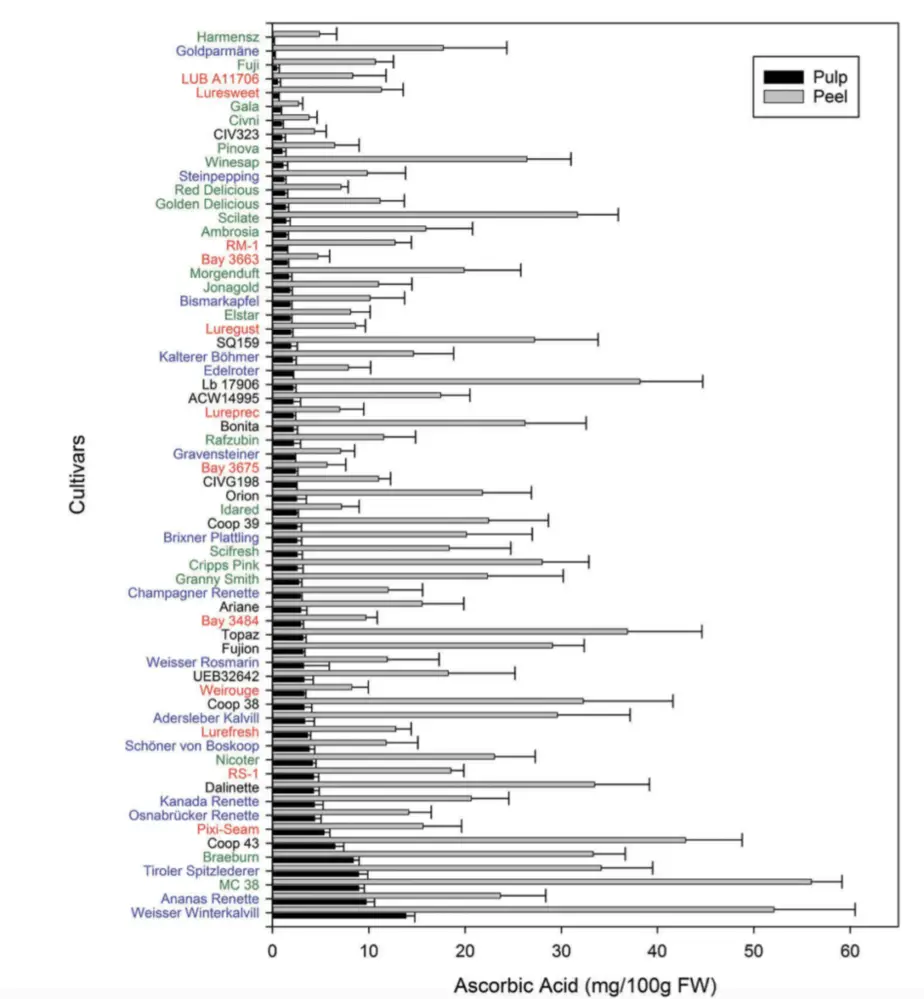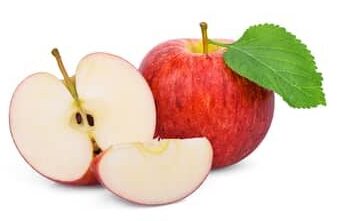
Nature and apple farmers have gifted us with many apple varieties to choose from.
Which type should you buy, if you’re looking for the healthiest apple? All apple types are good for you, but they vary in nutritional parameters like sugar content, antioxidant types and levels, amount of fiber, and vitamin and mineral levels.
Based on its overall nutritional profile, Granny Smith is the healthiest apple variety you can choose. It offers low sugar, high fiber, high mineral levels, and was shown to improve the gut bacteria associated with reducing obesity.

Different apple varieties have different nutritional strengths.
Summary of the Healthiest Apple Types Among Those Tested:
- Braeburn has the highest levels of vitamin C, followed by Granny Smith and Pink Lady
- Fuji, McIntosh, Red Delicious, Granny Smith and Jonathan have the highest antioxidant levels
- Granny Smith and Golden Delicious are lower in sugar
- Granny Smith is best at improving the healthy gut bacteria that may improve obesity
- Granny Smith is highest in fiber, magnesium, potassium and copper
Note: not all apple varieties have been tested for all these nutritional parameters. All resources are cited below.
More Apple Nutrition Tips:
- Old apple varieties are typically more nutritious that modern cultivars. Numerous studies have shown that older, less-commercially available varieites (“heirlooms”) typically have higher nutritional content, as with more vitamin C and a higher polyphenol content. So go to your local orchard or farmer’s market and choose varieties that you never heard of, and you will likely be choosing the most nutritious apples they have, as well as the most tasty (modern cultivars are often grown for appearance, size, anti-browning and other qualities versus taste).
- Organically grown produce has been shown in numerious studies to have superior nutritional profiles to non-organically grown produce. This is because organically-grown plants have to work harder to evade pests and disease, and their tools to do so are the polyphenol compounds that provide much of the nutritional benefits of apples to humans. Non-organic apples consistently rank high in the Environmental Working Group’s annual “dirty dozen” list of produce containing high amounts of pesticides.
- The majority of the nutrients are in the peel (the fruit’s first line of defense). So keep the peels on when you eat your apples. But the peel is also where pesticides linger, so again, buy organic, or wash apples thoroughly before eating. Here is how the FDA recommends that produce be cleaned. Read more on my blog about whether to eat the skin on many different types of produce here.
- Refrigerate apples to preserve their flavor and nutrition. They can last up to two months in the fridge.
Read on for more nutrition information by apple variety. Note: some websites purport to provide nutritional breakdown information for other apple types beyond what I show here; but you will find that this information is identical across varieties. They are just providing information for an average apple. I reviewed scholarly journals to get nutrition content for other specific types and have consolidated it all here.
Vitamin C Content By Apple Variety

This chart doesn’t provide exact numeric values, but you can see the relative amounts of vitamin C (ascorbic acid) across the x-axis. Of the commonly available varieties in most U.S. grocery stores, Braeburn packs the most vitamin C (it’s 5th from the bottom of this chart).

Source: This chart is from the study “Ascorbic acid content in apple pulp, peel, and monovarietal cloudy juices of 64 different cultivars” conducted in Italy, published in 2018.
Sugar Content By Apple Variety

Apple types vary significantly in sugar levels. This level of detail may be important for people with diabetes who need to monitor their sugar precisely. Of the apples tested in the USDA database, Fuji has the highest sugar levels per 100 grams, differing from the lowest sugar apple that was tested, Granny Smith, by 25%.
| Variety (100 grams) | Total Sugars |
| Fuji | 13.3 |
| Gala | 11.8 |
| Granny Smith | 10.6 |
| Honeycrisp | 12.4 |
| Red Delicious | 12.2 |
Source: U.S. Department of Agriculture Food Data Central
Fiber, Mineral and Vitamin Content By Apple Variety (per 100g)

Differences across varieties are relatively minor. Among the apple varieties available in the database, Granny Smith has an edge with its highest fiber content and highest levels of several minerals.
| Variety (100 grams) | Fiber (Total Dietary in mg) | Calcium (mg) | Mag-nesium (mg) | Phos-phorous (mg) | Pot-assium (mg) | Copper (mcg) | Vitamin B6 (mcg) |
| Fuji | 2.1 | 6 | 4.7 | 10 | 105 | 33 | 35 |
| Gala | 2.1 | 7 | 4.9 | 8 | 106 | 34 | 32 |
| Granny Smith | 2.5 | 5 | 5.1 | 10 | 116 | 35 | 28 |
| Honeycrisp | 1.7 | 4 | 4.2 | 8 | 98 | 23 | 33 |
| Red Delicious | 2 | 5 | 4.7 | 9 | 95 | 24 | 21 |
Note: All varieties tested had the same amount of zinc at 0.02 mg.
Source: U.S. Department of Agriculture Food Data Central
Antioxidant Content By Apple Variety
Polyphenols are antioxidants. They have numerous health benefits, including protecting cardiovascular health and reducing the risk of some forms of cancer.
Apples contain some of the highest concentrations of antioxidants across any single fruit or vegetable. Therefore, an apple a day is a great way to maximize your consumption of antioxidants and potentially keep the doctor away. The wisdom of the ages is proven out again.
Here is a summary of the antioxidant and total phenolic content in some popular varieties of apples. In this study, Fuji scored the highest in antioxidant activity, followed by McIntosh, Red Delicious, Granny Smith and Jonathan. Empire and Golden Delicious were notably lower.
| Variety (100 grams) | Antioxidant Activity (%)* | Total Phenolics (mg/100g) |
| Empire | <10 | 50.9 |
| Fuji | 98.3 | 101.9 |
| Gala | 47.7 | 85.2 |
| Golden Delicious | <10 | 82.2 |
| McIntosh | 76.0 | 106.7 |
| Red Delicious | 75.7 | 123.8 |
| Granny Smith | 72.1 | 134.5 |
| Jonagold | 24.2 | 139.7 |
| Jonathan | 72.0 | 108.1 |
*Antioxidant activity of 66 mg of apple tissue relative to that of 30 ppm α-tocopherol.
Source: New York Fruit Quarterly, Volume 8, Number 2: Summer 2000
Note: antioxidant content can depend on local growing conditions and may vary over time by variety, and even within a particular variety. Use this information directionally only.
Which Apple Color is Healthiest?

In general, darker colors are a signal that antioxidant levels are high. Go for the brightest red and green skins for maximum nutrition, but be sure to eat the peel to benefit from those nutrients (buy organic or wash well!) Granny Smith, with its green peel, is higher in carotenoids, a beneficial class of polyphenols; and Red Delicious, with its deep red peel, is higher in anthocyanidins, a different but also highly beneficial class of polyphenols.
Read more about carotenoids and what they do for you on my blog here.
Read more about anthocyanidins and what they do for you on my blog here.
Why Are Apples Good For You?
Apples are among the healthiest things you can eat because they offer such a high concentration of a variety of nutrients. Here are just some of the benefits of apples that science has learned of so far:
- Apples are high in antioxidants, which protect against some cancers and support cardiovascular health. They can help improve asthma and diabetes.
- Apples are one of the best sources of quercetin, an important antioxidant that can reduce the risk of heart disease, cancer, and degenerative brain disorders.
- Apples are one of the best sources of fiber, particularly pectin. Pectin is an insoluble fiber that can help reduce cholesterol, lower triglycerides, improve gut health, and aid weight loss by delaying stomach-emptying. It also may help lower blood sugar, relieve both diarhhea and constipation, and improve acid reflux.
Final Thoughts
Whichever apple variety choose, you can’t go wrong. It’s a great idea to buy a number of different varieties to maximize your exposure to the many varying benefits of apples. Ultimately, the healthiest apple for you is the one you’ll eat, so choose your favorite tasting apple. When in doubt, choose Granny Smith; otherwise, just eat an apple, any apple, every day, like the saying goes, for better health.
What cereal brand is highest in fiber? Find out here.
What’s the healthiest nut variety? Find out on my blog here.
Can’t stop eating potato chips or other salty snacks? Here is my guide on how to stop, and what to snack on instead.

Resources
- Condezo-Hoyos L, Mohanty IP, Noratto GD. Assessing non-digestible compounds in apple cultivars and their potential as modulators of obese faecal microbiota in vitro. Food Chem. 2014 Oct 15;161:208-15. doi: 10.1016/j.foodchem.2014.03.122. Epub 2014 Apr 3. PMID: 24837942.
- Hecke, K., Herbinger, K., Veberič, R. et al. Sugar-, acid- and phenol contents in apple cultivars from organic and integrated fruit cultivation. Eur J Clin Nutr 60, 1136–1140 (2006). https://doi.org/10.1038/sj.ejcn.1602430.
- Katarzyna Włodarska, Katarzyna Pawlak-Lemańska, Tomasz Górecki & Ewa Sikorska (2017) Classification of commercial apple juices based on multivariate analysis of their chemical profiles, International Journal of Food Properties, 20:8, 1773-1785, DOI: 10.1080/10942912.2016.1219367.
- Flavia Bianchi, Evelyn Soini, Flavio Ciesa, Laura Bortolotti, Walter Guerra, Peter Robatscher & Michael Oberhuber (2020) L-ascorbic acid and α-tocopherol content in apple pulp: a comparison between 24 cultivars and annual variations during three harvest seasons, International Journal of Food Properties, 23:1, 1624-1638, DOI: 10.1080/10942912.2020.1820515.
- Michele Bassi, Giuseppe Lubes, Flavia Bianchi, Sara Agnolet, Flavio Ciesa, Karin Brunner, Walter Guerra, Peter Robatscher & Michael Oberhuber (2017) Ascorbic acid content in apple pulp, peel, and monovarietal cloudy juices of 64 different cultivars, International Journal of Food Properties, 20:sup3, S2626-S2634, DOI: 10.1080/10942912.2017.1381705.
- Wojdyło A, Oszmiański J, Laskowski P. Polyphenolic compounds and antioxidant activity of new and old apple varieties. J Agric Food Chem. 2008 Aug 13;56(15):6520-30. doi: 10.1021/jf800510j. Epub 2008 Jul 9. PMID: 18611028.
- U.S. Department of Agriculture Food Data Central
- Environmental Working Group’s annual “dirty dozen
- https://www.fda.gov/consumers/consumer-updates/7-tips-cleaning-fruits-vegetables
- New York Fruit Quarterly, Volume 8, Number 2: Summer 2000
- Boyer, J., & Liu, R. H. (2004). Apple phytochemicals and their health benefits. Nutrition journal, 3, 5. https://doi.org/10.1186/1475-2891-3-5.
- Panche AN, Diwan AD, Chandra SR. Flavonoids: an overview. J Nutr Sci. 2016 Dec 29;5:e47. doi: 10.1017/jns.2016.41. PMID: 28620474; PMCID: PMC5465813.
- Kozłowska A, Szostak-Wegierek D. Flavonoids–food sources and health benefits. Rocz Panstw Zakl Hig. 2014;65(2):79-85. PMID: 25272572.
- Olano-Martin E, Gibson GR, Rastell RA. Comparison of the in vitro bifidogenic properties of pectins and pectic-oligosaccharides. J Appl Microbiol. 2002;93(3):505-11. doi: 10.1046/j.1365-2672.2002.01719.x. PMID: 12174051.
- Koutsos, A., Tuohy, K. M., & Lovegrove, J. A. (2015). Apples and cardiovascular health–is the gut microbiota a core consideration?. Nutrients, 7(6), 3959–3998. https://doi.org/10.3390/nu7063959.
- Tiwary CM, Ward JA, Jackson BA. Effect of pectin on satiety in healthy US Army adults. J Am Coll Nutr. 1997 Oct;16(5):423-8. doi: 10.1080/07315724.1997.10718708. PMID: 9322190.
- Schwartz, S. E., Levine, R. A., Weinstock, R. S., Petokas, S., Mills, C. A., & Thomas, F. D. (1988). Sustained pectin ingestion: effect on gastric emptying and glucose tolerance in non-insulin-dependent diabetic patients. The American journal of clinical nutrition, 48(6), 1413–1417. https://doi.org/10.1093/ajcn/48.6.1413.
- Brown, L., Rosner, B., Willett, W. W., & Sacks, F. M. (1999). Cholesterol-lowering effects of dietary fiber: a meta-analysis. The American journal of clinical nutrition, 69(1), 30–42. https://doi.org/10.1093/ajcn/69.1.30.
- Chutkan, R., Fahey, G., Wright, W. L., & McRorie, J. (2012). Viscous versus nonviscous soluble fiber supplements: mechanisms and evidence for fiber-specific health benefits. Journal of the American Academy of Nurse Practitioners, 24(8), 476–487. https://doi.org/10.1111/j.1745-7599.2012.00758.x.
- Miyazawa, R., Tomomasa, T., Kaneko, H., Arakawa, H., Shimizu, N., & Morikawa, A. (2008). Effects of pectin liquid on gastroesophageal reflux disease in children with cerebral palsy. BMC gastroenterology, 8, 11. https://doi.org/10.1186/1471-230X-8-11.
